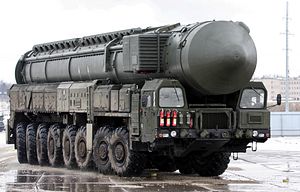Russia’s Strategic Missile Force (SMF) inducted 80 new improved Topol-M intercontinental ballistic missiles (ICBM) into service over the last five years, the SMF Chief of Staff Lieutenant-General Alexander Ponomarenko said in late December.
“Large-scale efforts were taken during this period to rearm troops with new missile systems. The troops received over 80 Yars missile system launchers, which made it possible to place 12 missile regiments on combat alert,” he said according to Russian state media.
The statement could not be independently verified.
The Topol MR (aka SR-24 Yars/NATO reporting name SS-27 Mod2), first revealed in 2010, is an improved variant of the Topol-M (aka RS12M2/NATO reporting name SS-27), a three-stage solid fueled ICBM with an estimated range of over 11,000 kilometers (6,835 miles). As I explained in January 2017:
The Yars, reportedly fitted with more advanced decoys and countermeasures than the Topol-M, and featuring a higher speed, has been specifically designed to evade Western anti-ballistic missile defense systems.
The Yars can reportedly carry three to six (earlier reports indicated ten) multiple independently targetable reentry vehicles (MIRVs). Each warhead can carry a yield of 150-500 kilotons.
The R-24 Yars can be fired from either hardened missile silos or transporter-erector launchers (TELs). According to previous estimates, the SMF currently operates 60 mobile and ten silo-based SR-24 Yars ICBMs. “The Yars will eventually replace older Topol-M models as the SMF’s road-mobile mainstay of its arsenal,” I explained in December 2016.
The SMF chief of staff also elaborated on the service’s testing activities. “Over this period [2012-2017], more than 40 successful launches of intercontinental ballistic missiles were conducted. They confirmed the reliability of our combat missile complexes and the high skills of the personnel,” Ponomarenko.
The SMF launched a Topol-M at the Kapustin Yar site in south Russia’s Astrakhan Region in late December 2017, testing “perspective [sic] armament,” according to the Russian Ministry of Defense, most likely another reentry vehicle design. The SMF also test fired four intercontinental-range ballistic missiles (ICBMs) as part of a routine exercise in October 2017, as The Diplomat reported.
“R&D work was carried out to develop new missile systems and their armament capable of breaking through a missile shield both today and in the future,” Ponomarenko added. “Now work is underway to develop the Sarmat missile system equipped with a heavy liquid-propellant missile to replace the Voyevoda ICBM.”
The RS-28 Sarmat is a new super-heavy ICBM (NATO designation: SS-X-30 Satan 2) is expected to enter service by 2020, replacing Soviet-era RS-36M ICBMs. It will become the mainstay of the SMF’s silo-based ICBM force in the near future. “The Sarmat can reportedly carry ten heavy or 15 (some sources say 16) lighter warheads. The new ICBM can allegedly also be fitted with a new hypersonic glide vehicle (HGV), the YU-71, currently in development under the secret Project 4202.” I explained previously.
The Sarmat program, however, has encountered a number of delays in 2017 and has not been test fired as originally planned by the ministry of defense.
































